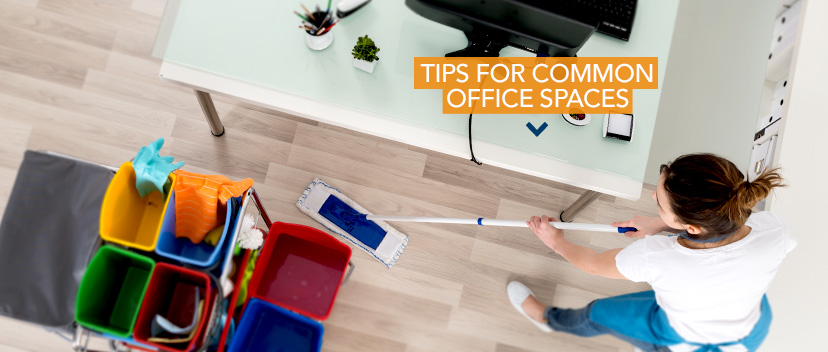Break room, common room, kitchen…whatever your company calls it, the purpose is the same: to provide a shared space for employees to relax, eat and unwind from the stresses of a day on the job. All break rooms, regardless of the organization or the employees that inhabit them, have one thing in common: they’re one of the most commonly used and populated rooms in a workplace.
One room continuously cohabited by a large volume of people guarantees one thing: germs, and lots of them. During cold and flu season especially, you can be sure that a microbiological zoo of bugs is thriving on the handle of every refrigerator and on the buttons of every microwave. While the accumulation of germs, bugs and other microbiological monsters can’t be mitigated by one clean forever, there are some common measures that you and your coworkers can take to make the break room a cleaner—and subsequently safer space —for everyone.
If your shared spaces continue to be dirty, even after you press staff to follow these simple tips, it might be time to contact a commercial cleaning company.
1. All Hands on Deck
Although washing your hands is one of the most common tips for office cleanliness, an alarmingly high percentage of people don’t do it! 39% of people don’t wash or disinfect their hands after coughing or sneezing, and more than half of Americans don’t wash their hands after touching shared equipment, public transportation and other heavily trafficked surfaces1.
That’s a lot of germs being transferred onto the keyboards, phone handles and desk tops of your workplace. Beyond desks and door handles, a lot of those germs are making their way into your break room or kitchen, where employees are transferring them directly into their mouth or onto their face.
Washing your hands regularly when transferring between spaces in your workplace, say from your desk to the break room, cuts down on the spread of germs between spaces and people. We know washing hands is a common best practice, but with a large percentage of people skipping this fundamental step altogether, enforcing it in your workplace with signage, email reminders or investing in supplies of alcohol-based hand sanitizers can make all the difference.
2. Common Space Requires Common Attention
Break rooms feature some of the most commonly used and widely shared surfaces in a workplace, such as:
Countertops
Door Knobs and Handles
Tables, Chairs And Other Furniture
These spaces are used by virtually everyone in a work environment; infrequent cleaning or disinfecting of these surfaces allows germs and bugs to thrive and transfer between members of your team. It only takes one sick employee to decommission an entire office from the spread of germs on commonly shared surfaces.
Door knobs and handles are one of, if not the most, commonly touched and used surfaces in a workplace, making them a prime breeding ground and transfer source for germs and viruses. Washing your hands after touching door knobs, or disinfecting door knobs frequently are quick and simple ways to cool down this commonly overlooked hot bed of microbiological activity.
Pro tip: Keep alcohol-based hand sanitizers or spray near the doorways of your break room, and other highly trafficked rooms, to encourage frequent cleaning and keep cleanliness top of mind to your staff.
3. The Nooks & Crannies
While your break room is full of commonly touched and used surfaces like doorknobs and handles, it’s also home to many overlooked spaces. Refrigerator handles, sink knobs, drawers and microwave buttons are all commonly overlooked places that can be fertile breeding grounds for a nasty strain of flu or the common cold.
On average, you touch 300 surfaces every 30 minutes, exposing you to over 840,000 germs2. That’s 1,680,000 every hour, not taking into account odd angles and edges that aren’t commonly disinfected or cleaned by janitorial staff or coworkers.
Simply wiping down common and uncommon surfaces with a disinfecting wipe can drastically cut down on the amount of germs or bugs present. Engage your janitorial staff to conduct a cleaning audit of your workplace to identify forgotten areas and build them into your regular cleaning plan.
4. Some Food for Thought
While maintaining sanitary conditions on the exterior of the communal fridge is key to keeping your business’s break room clean, maintaining order inside is crucial as well. If your break room ice box has an ice scooper, use it; if not, every employee that uses ice is dipping their hands into a germ infested area, prone to housing bugs and viruses.
Clean old food, spills and crumbs out of the fridge often; no one wants to find takeout from six months ago after it’s turned blue. Crumbs and old food left to sit, and subsequently rot, are prime sources for harmful bacteria to flourish, jeopardizing the health of the entire office.
In Conclusion
The benefits of keeping your work place’s commonly used areas as clean as possible will have adversely positive health benefits for you and your staff. Washing your hands, disinfecting shared surfaces as well as the surfaces that no one considers when cleaning, will help mitigate the spread of germs and viruses between surfaces and individuals.
Even if your office employs a janitorial service, it’s still possible that they’re not giving your break room the necessary scrub down it needs. If you think your janitorial staff is lacking, learn how a commercial cleaning service professionally alleviates the propagation of productivity, destroying bugs and germs.
Sources:
- Americans’ Hand Hygiene Habits, Businesswise
- Americans’ Hand Hygiene Habits, Businesswise


One thought on “4 Tips to Disinfect the Dirtiest Shared Spaces in Your Office”
Comments are closed.